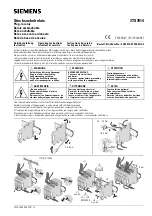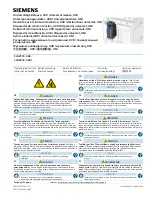
BE1-CDS220
Testing And Maintenance
13-37
Sidebar 13-5. Average Restraint Operating Characteristic
Operating in an average restraint characteristic, the BE1-CDS relay reaches the trip or operate point
depending on the level of restraint per the diagram below.
As illustrated in the associated diagram, when only one current is changed, the restraint current will vary
depending on the relative change in currents. As one current is decreased from balance, the average
restraint will shift to the left with a sloping characteristic as the differential current increases to the point of
operating. The average restraint will shift to the right with a sloping characteristic when one current is
increased relative to the other as the differential current increases.
1
2
3
4
5
AVERAGE RESTRAINT CURRENT (IN MULTIPLES OF TAP)
OPER
AT
IN
G C
U
R
R
EN
T
(I
N
M
U
LT
IPLES OF
T
AP)
123
Slo
pe
minimum pickup
decreasing current
from balance
increasing current
from balance
D2857-14.vsd
10-15-99
Average Restraint Operating Characteristic
Sidebar 13-6. Average Restraint When Increasing One Input from Balance
In order to test the restrained pickup function of the BE1-CDS relay, you may increase one of two currents
initially applied in balance, to create an operate imbalance. In this narrative, the input 1 current will be the
input to be changed. A similar analysis can be made for changing input 2 current.
By increasing input current I
1
from balance, I
1trip
is defined as:
I
1trip
= I
2balance
*(1+((2*
100
slope
)/(2-
100
slope
))) in per unit
Sidebar 13-6, Equation 1
with the minimum trip point established as:
I
1trip min
= I
2balance
+ minpu in per unit
Sidebar 13-6, Equation 2
where: minpu is the minimum pickup setting.
Under test and in-service conditions, the following equations determine whether the relay operates along
the flat minimum pickup or slope of the operating characteristic. If:
I
restraint at balance
> minpu x
−
2
/
1
100
/
slope
1
in per unit, use Equation 1, or if
I
restraint at balance
< minpu x
−
2
/
1
100
/
slope
1
in per unit, use Equation 2.
Summary of Contents for BE1-CDS220
Page 2: ......
Page 10: ...viii Introduction BE1 CDS220 This page intentionally left blank...
Page 36: ...ii Quick Start BE1 CDS220 This page intentionally left blank...
Page 48: ...ii Input And Output Functions BE1 CDS220 This page intentionally left blank...
Page 66: ...iv Protection and Control BE1 CDS220 This page intentionally left blank...
Page 112: ...ii Metering BE1 CDS220 This page intentionally left blank...
Page 116: ...5 4 Metering BE1 CDS220 This page intentionally left blank...
Page 166: ...ii BESTlogic Programmable Logic BE1 CDS220 This page intentionally left blank...
Page 176: ...7 10 BESTlogic Programmable Logic BE1 CDS220 This page intentionally left blank...
Page 234: ...8 56 Application BE1 CDS220 This page intentionally left blank...
Page 236: ...ii Security BE1 CDS220 This page intentionally left blank...
Page 240: ...9 4 Security BE1 CDS220 This page intentionally left blank...
Page 242: ...ii Human Machine Interface BE1 CDS220 This page intentionally left blank...
Page 256: ...10 14 Human Machine Interface BE1 CDS220 This page intentionally left blank...
Page 258: ...ii ASCII Command Interface BE1 CDS220 This page intentionally left blank...
Page 422: ...14 32 BESTCOMS Software BE1 CDS220 This page intentionally left blank...
Page 424: ...ii Time Current Characteristics BE1 CDS220 This page intentionally left blank...
Page 452: ...ii Terminal Communication BE1 CDS220 This page intentionally left blank...
Page 456: ...C 4 Terminal Communication BE1 CDS220 This page intentionally left blank...
Page 458: ...ii Settings Calculations BE1 CDS220 This page intentionally left blank...
Page 475: ......
















































